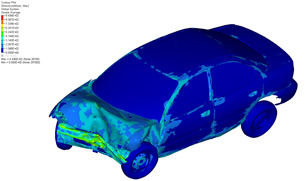RADIOSS Is at the Center of HyperWorks Enterprise Simulation Platform
Next-generation solver uses the latest finite element technologies to increase analysis efficiency and accuracy.
Latest News
November 12, 2008
By Margaret S. Gurney
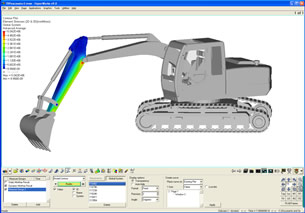 Contour plot showing element stresses in 2D & 3D. |
“Under Altair’s unique HyperWorks business model, clients have realized that shifting or consolidating from a multiple-solver environment to RADIOSS generates immediate cost-savings while providing access to over 30 additional CAE software titles at no incremental cost.” |
Quick Optimization Studies
RADIOSS is said to be suitable for a complex range of physics problems including noise vibration and harshness, crash analysis, drop testing, terminal ballistics, and explosions. It provides what the company describes as “superior” model checking, error messaging, and results accuracy. RADIOSS deploys up-to-date finite element formulations that enhance overall results accuracy.
Altair describes RADIOSS as “optimization ready,” by which it means that you can convert models into optimization problems easily and quickly. It also means that RADIOSS uses memory management techniques and efficient algorithms that can compute large models rapidly. Simulation results, Altair says, do not vary with number of processors used to solve explicit analysis problems, making RADIOSS highly parallelized and linearly scalable for additional computation efficiency.
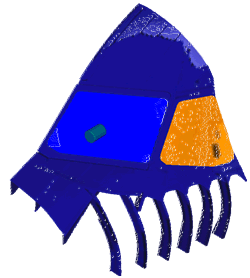 Fluid-structure interaction as seen in a bird strike. |
Multiphysics capabilities within RADIOSS include fluid-structure interaction, aero-acoustics analysis, and external aerodynamics. A comprehensive material library listing correlated material laws and rupture models with definitions for concrete, foam, rubber, steel, composites, biomaterials, and more is standard.
When coupled with the company’s HyperCrash, RADIOSS provides a highly tuned and automated crash simulation environment. Since it is tightly integrated with Altair’s HyperStudyDSS, optimization and design robustness studies can be performed quickly.
Linear Analysis Capabilities
Altair describes RADIOSS for Linear as the modern alternative to NASTRAN. To facilitate legacy and client data import and conversion, RADIOSS directly supports NASTRAN input and output data file formats. It features six degrees-of-freedom per grid shell element formulations, which eliminates problems resulting from AUTOSPC and K6ROT factors.
RADIOSS for Linear offers solver technology for linear statics, inertial relief, eigenvalue calculation, buckling, direct and modal frequency response, direct and modal transient response, random response, and NVH solution sequences.
RADIOSS also supports ply-based composite data input, and it can simulate structures with millions of degrees of freedom without any model size restrictions.
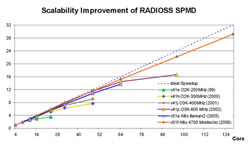 Scalability improvement of RADIOSS SPMD. (Click graph for larger version.) |
Under static loading, RADIOSS can predict structural deformation and stresses for models subject to point forces and moments, pressure, thermal, gravity, and centrifugal loads. In addition to fixed boundary conditions, inertia relief analysis can be performed for free-form structures.
Analysis results output include element stresses, strains, strain energy, and forces; displacements and forces at grid points; applied loads, boundary condition reaction, and rigid element forces. Linear-buckling analysis can be performed by RADIOSS to identify the buckling factors at which a structure becomes unstable due to an applied load.
RADIOSS analyses can identify resonant frequencies and the mode shapes associated with those frequencies. In addition to natural frequencies and mode shapes, RADIOSS can output element modal stresses and strain energies Eigenvalue analysis can be performed using the built-in Lanczos solver or AMLS solver.
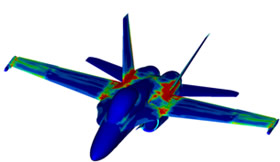 Linear dynamics demonstrated. | 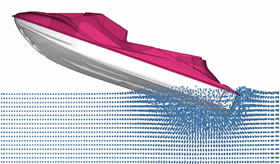 Fluid-structure interaction in a recreational watercraft. |
The linear steady state heat transfer analysis calculates the temperature field in a structure subjected to applied thermal loads. The thermal solution in RADIOSS allows for structures with both isotropic and anisotropic thermal material properties.
Other Linear Analysis Capabilities
For contact analysis, RADIOSS uses a quasi-static nonlinear solution. To solve the complex problem of modeling contact interactions between non-matching meshes, RADIOSS uses a grid to element gap element (CGAPG) that can be easily modeled in HyperMesh.
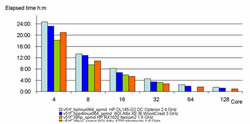 Elapsed time chart shows RADIOSS’ results and scalability. (Click graph for larger version.) |
Advanced capabilities include handling initial penetration and using a coulomb friction model when there is a sliding contact.
Also, complex material composites can be analyzed using RADIOSS to derive homogenized anisotropic shell properties from composite layup information and HyperMesh’s laminate modeler helps to quickly define composite stacks.
Coupled fluid-structure frequency response in RADIOSS can be used to determine passenger compartment sound levels due to road and powertrain noise (NVH). This analysis simulates the transfer of energy (as sound pressure) from the vehicle structure to the air inside the cabin. The coupling matrix between the wetted structural surface and the surface of the fluid mesh is determined automatically.
Available as an internal capability of RADIOSS is stress-life or High Cycle S-N curve-type fatigue analysis. This methodology is relevant when the applied stress is primarily in the elastic range of the material and the resulting fatigue life (cycles to failure) is long.
Plus, response characteristics of a system subjected to sinusoidal inputs at varying frequencies can be calculated in RADIOSS, as well as transient analysis, which calculates the system response to a prescribed time-varying input. And last, superelement modeling is used to decompose large structures into substructures.
Nonlinear Analysis Capabilities
RADIOSS for Non-Linear offers simulation capabilities that represent a mature and proven suite of analysis algorithms, says Altair. The company also notes that many of the capabilities in RADIOSS for Non-Linear were developed in collaboration with industry specialists, which has resulted in accurate solutions for realistic applications such as advanced material and rupture models.
The multiphysics solution in RADIOSS enables engineers to study the design and robustness of products by simulating models using realistic boundary conditions. Additionally, you can mix libraries and models and user-defined subroutines to develop custom material laws and rupture models enables engineers to introduce the rupture model into the material law to accurately simulate any phenomena.
Crash worthiness of an auto. |
Crash and safety performance can be modeled for airbags, modeling the gas flow inside using the finite volume (ALE) method. RADIOSS handles the buckling and continuously maintains the contacts during complex scenarios.
Nonlinear solution capabilities include multiphysics, metal forming and metal stamping, contact interfaces, ALE, SPH, multiple domain modeling, submodeling, CFD-noise analysis, composites, material law library, rupture model library, failure models, safety library, dummies, barriers, and impactors. This includes a partnership First Technology Safety Systems (FTSS) (see link below).
Altair Engineering, Inc.’s Director of Solver Technology, Dr. Harold Thomas, explains “There is no other solver offering on the market today that provides the combination of solution scope, scalability and accuracy of RADIOSS. RADIOSS continues to win benchmarks against NASTRAN and has established a commanding presence in the crash analysis market. Under Altair’s unique HyperWorks business model, clients have realized that shifting or consolidating from a multiple-solver environment to RADIOSS generates immediate cost-savings while providing access to over 30 additional CAE software titles at no incremental cost.”
Company Support
Altair backs RADIOSS and its entire HyperWorks portfolio with a comprehensive support program ranging from newsletters to online tips and tricks to message boards in addition to traditional phone and e-mail service.
The company offers free 40-minute webinars in a HyperWorks Industry Vertical Webinar Series to improve the efficiency of your CAE programs, optimize the earlt stage of your deigns, and reduce time and costs (see link below.)
Additionally, the company offers the HyperWorks Enabled Community (HWEC), a user- and partner application community where Partners’ applications and technical support become part of the HyperWorks platform and are available to users on-demand under one simple licensing model.
For complete details on HyperWorks and RADIOSS for Linear and Non-Linear analysis, go to Altair Engineering.
Read why DE’s editors chose this as a Pick of the Week.
Access the home page devoted to RADIOSS.
Upcoming RADIOSS Webinars – topics and dates.
Read about Altair’s partnership with First Technology Safety Systems (FTSS).
Visit the HyperWorks site specifically.
Check in with the HyperWorks Enabled Community.
Margaret S. Gurney is the editor for new products at Desktop Engineering magazine.
Subscribe to our FREE magazine, FREE email newsletters or both!
Latest News
About the Author
DE’s editors contribute news and new product announcements to Digital Engineering.
Press releases may be sent to them via [email protected].







